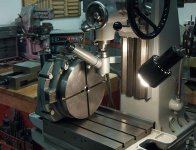so current thinking....find a scope for the M1 and lap to fit. For the W12, I thought of hacking an old microscope and making one. even a cheapo is pretty good at 40x...thinking 4x objective and 10x eyepiece. I'd either buy a graticule or make one (strands of dental floss). I had the idea that if you made the graticule slight eccentric in a slightly eccentric seat, you could rotate it into perfect centre position then lock it in place.
The M1 is in pieces pending paint. I look at it and wish all machines were made as well. Its a beautiful little machine. It is very interesting how things like the thread error correction was done. It has the full rotary table and an 8mm spindle, every bearing surface shows all the original scraping so I think its good one. Only problem is the paint was literally falling off, and no scope.
As part of this acquisition I got an Aciera F1 and Schaublin 70 (second one lol). Christmas came early!! I've stripped and cleaned the F1. I'm going to replace the needle bearing, the races look good but I'm not sure on the bearing As nice as this mill is, I really don't like this design of spindle bearings using the the shaft and housing as races. What do I know on mill design vs Aciera and Deckel etc, but come on, bearings don't last forever and you'd hope your precious machine tools would not have to be tossed after a worn out spindle bearing




